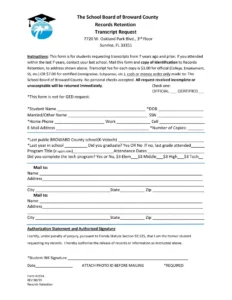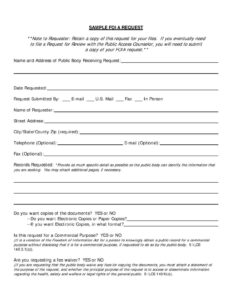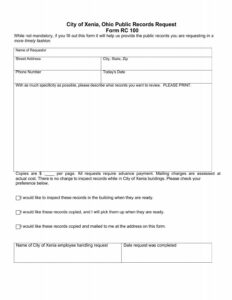Utilizing these structured formats offers several advantages. Properly completed forms increase the likelihood of a prompt and efficient response from agencies, minimizing delays and potential misunderstandings. They also help requesters articulate their needs precisely, leading to the retrieval of the correct information. Furthermore, these resources empower citizens to exercise their right to access public information, fostering greater government transparency and public engagement.
This article delves further into the practical aspects of acquiring public records in California, covering topics such as identifying the appropriate agencies, understanding different record types, navigating potential challenges, and utilizing online resources.
Key Components of a California Public Records Request
Effective requests for Californian public records generally incorporate several key elements to ensure clarity and completeness. These components facilitate efficient processing by agencies and increase the likelihood of receiving the desired information.
1. Requester Information: Clear identification of the individual making the request, including full name, mailing address, telephone number, and email address is crucial for facilitating communication and delivery of responsive records.
2. Agency Identification: Precisely identifying the specific government agency holding the requested records is essential. This includes the agency’s full name and, if applicable, the specific department or division.
3. Description of Records: A detailed and unambiguous description of the sought-after records is paramount. Specificity regarding dates, titles, file numbers, or any other relevant identifying information significantly aids the retrieval process. Vague or overly broad requests may be denied or result in delays.
4. Preferred Format: Specifying the desired format for receiving the records (e.g., paper copies, electronic files, specific file types) allows the agency to prepare the information accordingly and avoid potential compatibility issues.
5. Fee Waiver Request (if applicable): If the requester believes they qualify for a fee waiver based on the purpose of the request (e.g., journalistic, academic, non-commercial), this should be clearly stated and justified. Supporting documentation might be necessary.
6. Method of Delivery: Indicating the preferred method for receiving the records (e.g., mail, email, pick-up) streamlines the delivery process and ensures timely access to the information.
7. Date of Request: Including the date of the request establishes a clear timeline for processing and allows for tracking the progress of the request.
Careful attention to these elements helps ensure a smooth and successful process when requesting public records in California. Complete and well-structured requests facilitate efficient processing by agencies and contribute to timely access to government information.
How to Create a California Public Records Request
Creating a well-structured request increases the likelihood of a prompt and efficient response from Californian agencies. Careful attention to detail and adherence to legal requirements, such as those outlined in the California Public Records Act (CPRA), are essential. The following steps outline the process of crafting an effective request.
1: Determine the Appropriate Agency: Identifying the correct agency holding the desired records is the first crucial step. Researching agency jurisdictions and responsibilities is often necessary.
2: Consult Agency-Specific Resources: Many agencies provide online resources, including sample request forms or specific instructions. Utilizing these resources can streamline the process and ensure compliance with agency-specific procedures.
3: Draft the Request: A formal written request is generally recommended, though some agencies may accept requests via other channels. The request should clearly state the requester’s contact information, the specific records sought, and the preferred format for receiving the information.
4: Describe the Records with Precision: Providing a detailed and unambiguous description of the records is crucial. Including dates, titles, file numbers, or other relevant identifiers significantly increases the efficiency of the retrieval process.
5: Specify the Preferred Format: Indicating the desired format (e.g., paper copy, electronic file) ensures the agency can provide the information in an accessible manner.
6: Include a Fee Waiver Request (if applicable): If a fee waiver is sought, the request should clearly state the justification and provide any necessary supporting documentation.
7: Submit the Request: Follow the agency’s specified submission procedures. This may involve mailing a physical copy, submitting an online form, or sending the request via email.
8: Maintain Records of the Request: Keeping copies of the request, correspondence with the agency, and any related documentation is essential for tracking the request’s progress and addressing potential issues.
Adhering to these steps promotes a smooth and efficient process for obtaining public records from Californian agencies. Thorough preparation and clear communication contribute significantly to successful information retrieval and uphold the principles of government transparency.
Access to government information empowers individuals and strengthens democratic principles. Standardized formats for requesting public records in California serve as vital tools for facilitating this access. They provide a structured framework for clear communication between the public and government agencies, promoting efficiency and transparency throughout the request process. Understanding the key components of these formats, coupled with a grasp of effective request procedures, enables individuals to exercise their right to information effectively. From precise record descriptions to the proper identification of agencies and the potential utilization of fee waivers, each element plays a crucial role in ensuring requests are processed smoothly and efficiently.
Open access to public information is essential for accountability and informed civic engagement. Leveraging available resources and adhering to established procedures ensures these mechanisms function optimally, fostering a more transparent and participatory government. Continued efforts to simplify and streamline access processes further empower citizens and strengthen the foundations of a well-informed populace.



